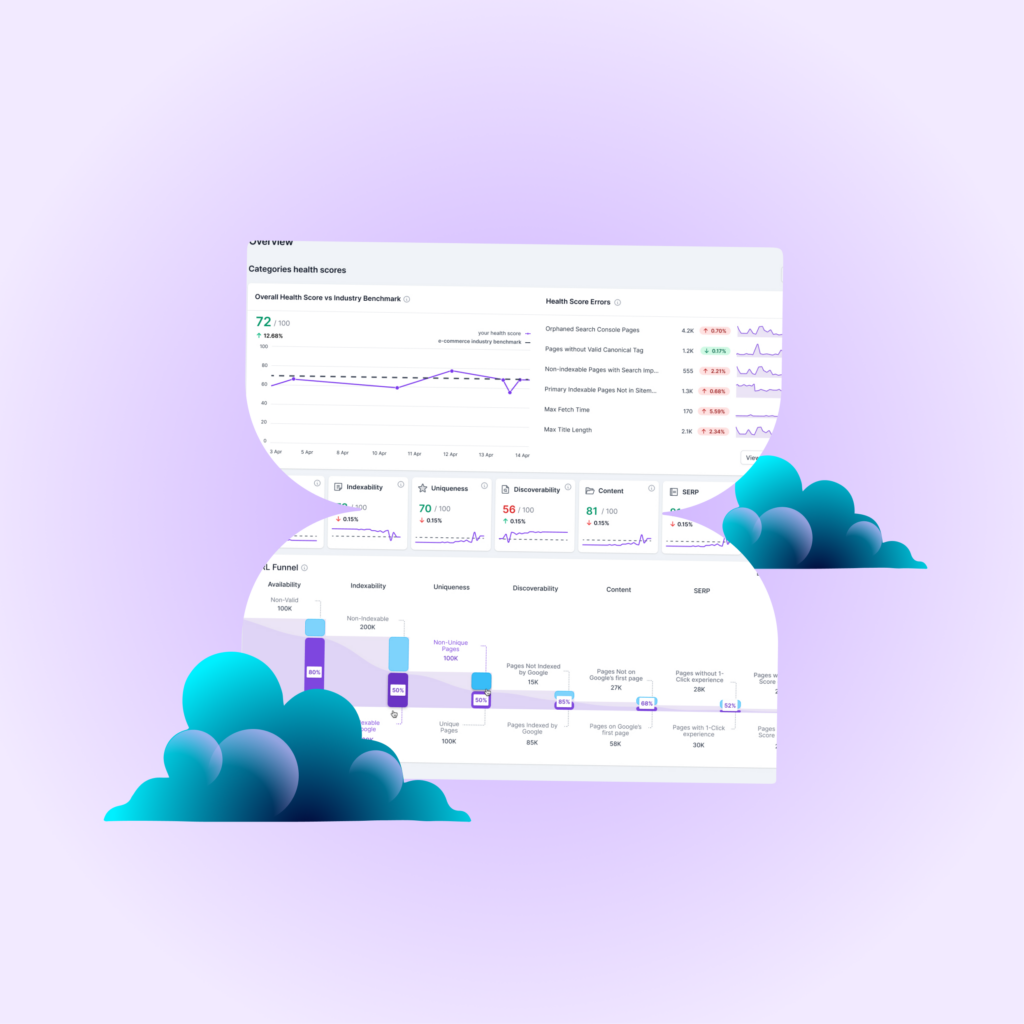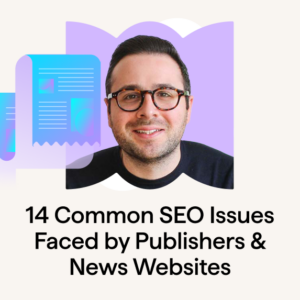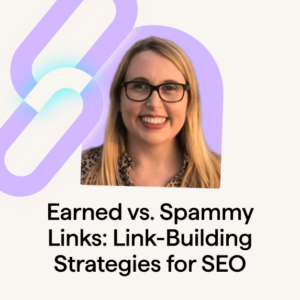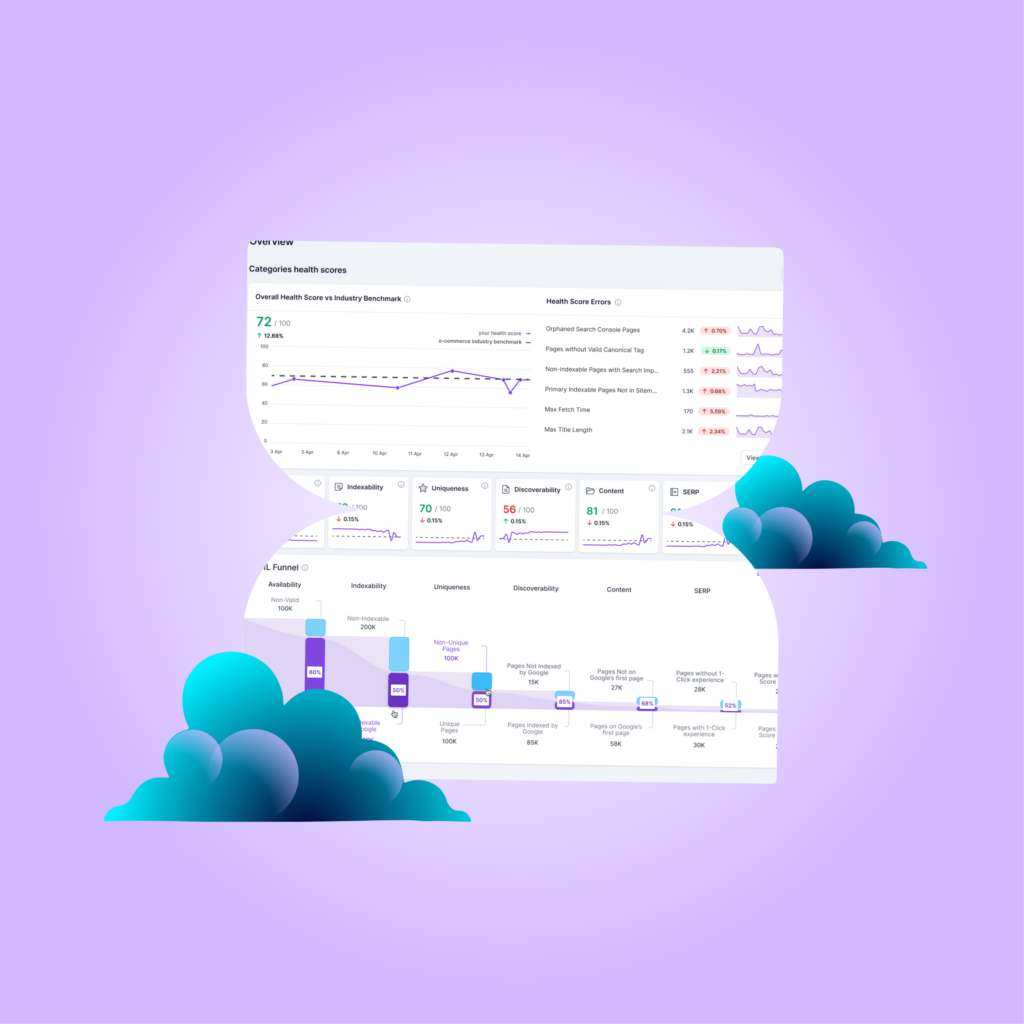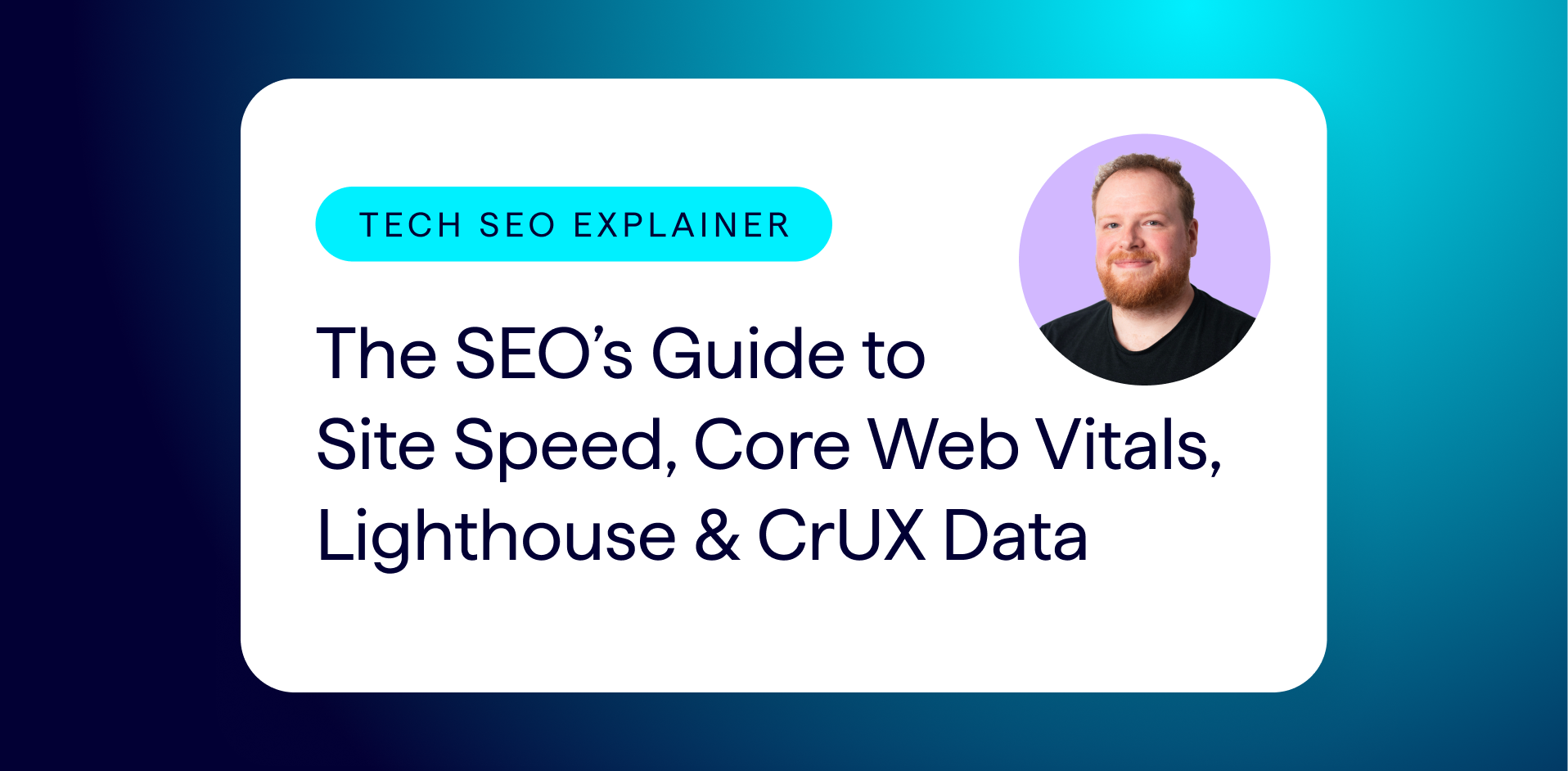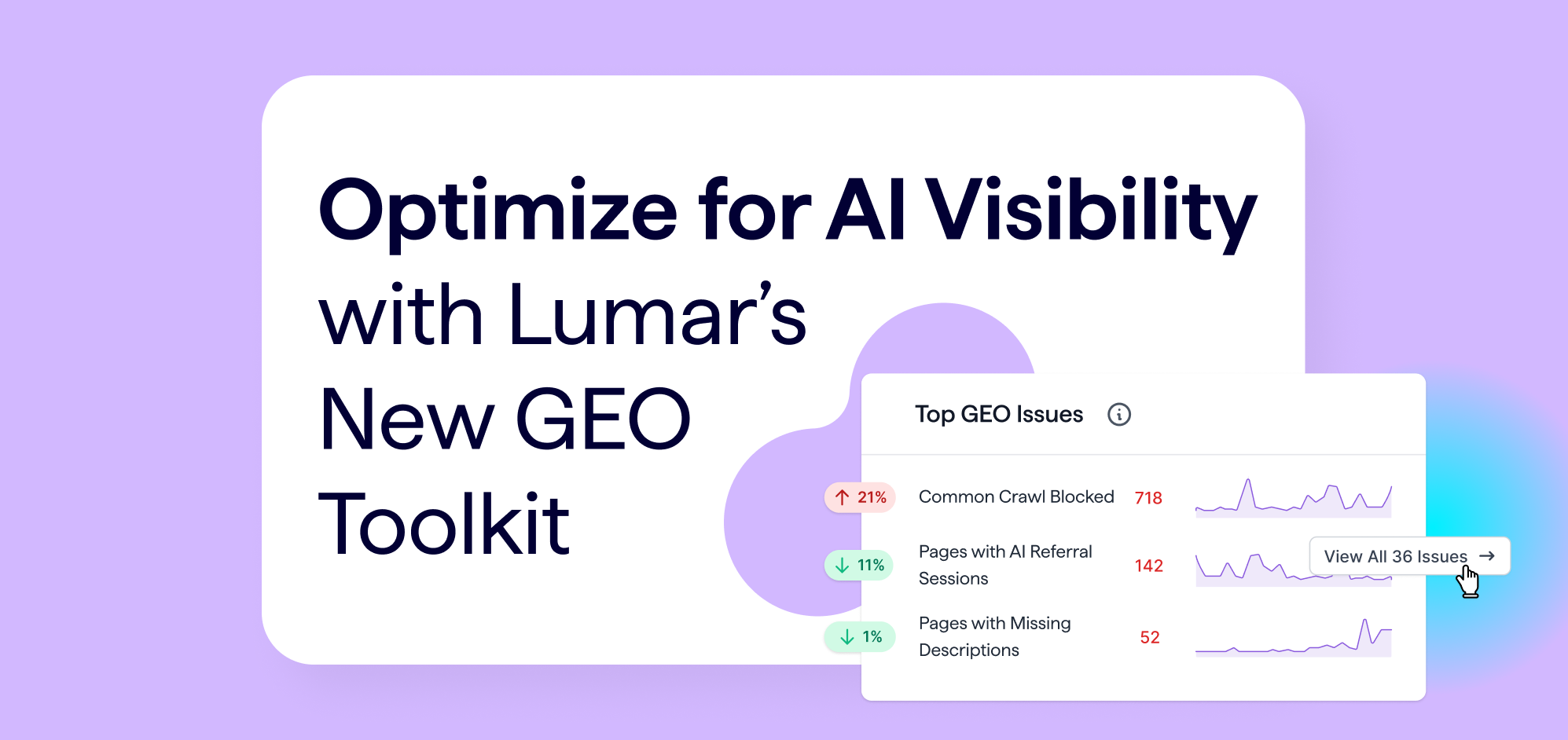“News SEO… is fast-paced, focuses on a few very key things, and requires more immediate attention than any other type of search engine wizardry.”
Now, this post is not an exact guide on how to execute SEO for news websites perfectly — your SEO strategy will vary depending on how your specific news organization is structured. Here, I provide the concepts, processes, and tools to help you navigate the potentially treacherous paths associated with publisher SEO.
High content volumes, an ever-changing product, limited tech resources, and an incredible organizational appetite for constant progress… All things that terrify SEOs.
“Progress,” I hear you cry, “That’s not what I signed up for!”
That’s why you need a plan. Something you can fall back on when you aren’t sure where to focus your time and efforts.
Of course, when it comes to implementing SEO strategies on a large publication’s website, whatever you do, you will need to get buy-in from stakeholders in editorial, tech, and product teams (among others).
This article should help you understand where to focus your time and what is likely to make a difference when it comes to publisher SEO.

About the Author: Harry Clarkson-Bennett is Director of SEO at The Telegraph. In previous roles, he has led agency SEO teams, worked for a market-leading affiliate and lead generation company, and has launched multiple affiliate websites over the years.
TL;DR
- News SEO is a completely different beast than other types of SEO. You have one true chance to get things right: when the article is published.
- More so than in any other industry, SEOs in the publishing space will be reliant on the relationships they build between many different departments.
- The larger and more complex the site, the more likely it is that technical SEO resources will add significant value.
- The opposite is true of digital PR and link acquisition — the larger the site and the higher the content volume, the less value digital PR and off-site SEO will bring.
First of all, what is ‘publisher SEO’ — and how does it differ from more ‘traditional’ SEO?
Publisher SEO is the practice of optimizing the content of publishing websites like newspapers, magazines, and sports publications that cover news, events, incredibly detailed evergreen guides, affiliate content, and everything in between.
The end goal for all businesses is revenue. Publishers are no different. Your job as an SEO is to drive high-quality traffic to these pages. Whether that’s through optimizing headlines, creating evergreen content or event plans, or improving the quality of a site’s technical SEO (more on that later), it entirely depends on the situation you find yourself in.
How SEO for news websites differs
The fundamental concepts across SEO should always lead you back to satisfying your users. For publishers, all users want to read high-quality content that loads quickly on a site that is easy to navigate. Create quality content that loads quickly and is easy to find… Easy.
The difference really lies in the sheer volume of content created, the legacy of years or even decades of content (with varying degrees of quality), and the monetization frameworks of these sites. Without earning their crust through product sales, the reliance on advertising, affiliate revenue, and paywalls makes publisher SEO a different proposition to working on an e-commerce site or a SaaS model.
Having worked at SEO agencies and on all different types of sites, I can confidently say that publisher websites — particularly ones that create news content — are the most different. The pace and optimization tactics you can employ are very different from everything you were taught (or learned) in your formative SEO years.
How does Google handle news content?
Interestingly — or badly — depending on your point of view.
Google’s problem with news content is the speed at which the industry moves. Even dealing with a single publisher that creates hundreds of articles each day is a challenge for search engines. Multiply that by however many news publishers exist on the web and you’ve got yourself a serious problem when it comes to identifying and prioritizing high-quality, relevant content in a split second.
Understanding how Google crawls websites is really important to give your news content the best chance of success. Barry Adams’ article titled Advanced Insights into Googlebot Crawling is the best resource out there for understanding how crawlers deal with news content.
Google’s “Top Stories” block
Ultimately, for news content, everything relies on the first crawl. Due to the rapid speed of news publishing, you have one chance to get things right; your article’s first crawl may be its only chance to rank in Google’s Top Stories. Any headline tweaks or article optimizations are not guaranteed to be picked up in time to improve your ranking in the Top Stories block (the holy grail for publishers). By the time these changes are picked up, you might have missed the boat.
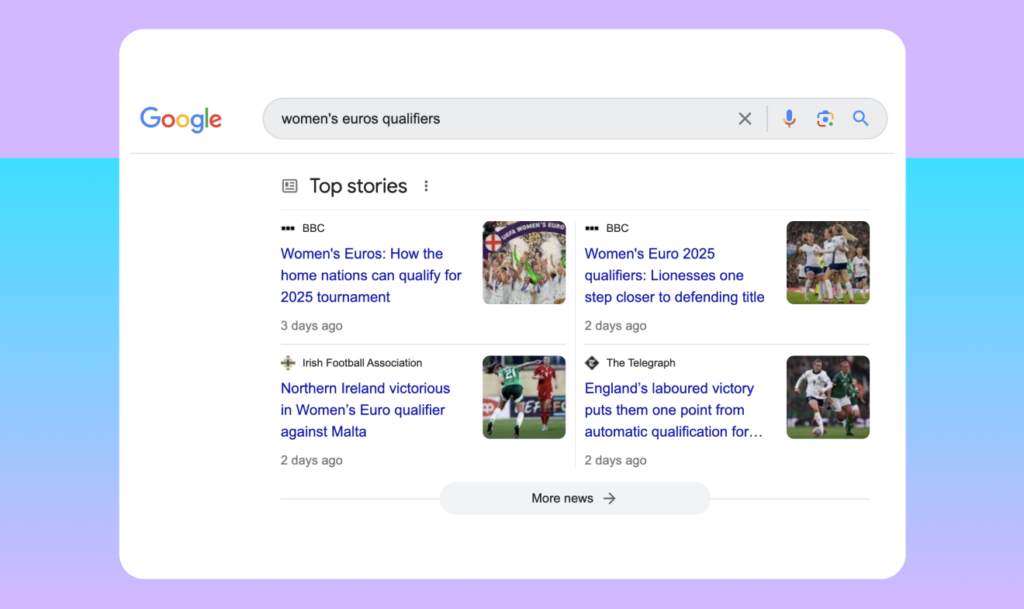
To generate the “Top Stories” block, Google is reliant on your article’s prominence on your homepage, the Google News sitemap, your structured data and the headline (among other factors, of course) to make a split-second ranking decision. You have to make it easy for crawlers to access and understand your most valuable content. Google is unbelievably sophisticated , but it cannot truly understand content. Particularly news.
Top tip: Redirects are particularly valuable when it comes to news and the Top Stories block. If an article hasn’t been picked up in Top Stories, then creating a new file and redirecting the page to a new URL seems to make Googlebot treat the page as an entirely new URL. Particularly if it re-enters your Google News Sitemap. Counter-intuitive, but it works.
Key SEO tips and tricks for news websites
I have found it incredibly useful to have some guiding principles that help steer me through SEO decisions when planning for events, improvements, or new features.
1) Don’t aim for perfection
Don’t obsess over making everything perfect. When you work on a website that creates news content, publishes hundreds of articles a day, and has dozens of different departments and projects going on that you will never find out about (trust me), you have to know what is and, almost more importantly, what isn’t a priority.
Does taking your CLS score from 80% to 95% achieve anything extra? Does the lack of meta descriptions or title tags on very old content really present an issue?
2) Only push through SEO initiatives you are confident about
Tech resource is at a premium in news organizations and SEO is not necessarily thought of as the holy grail of all things (devastating, I know). So, you need to clearly articulate the benefits of your projects. If I can’t clearly understand what value a ticket adds, I remove it.
The more you do that doesn’t add value, the less likely you are to get SEO fixes implemented. It’s a simple ROI decision.
3) Ensure your content can be rendered by crawlers
Publisher websites tend to be heavy, clunky, and rich in third-party code, JavaScript-laden features, iFrames, and so on. Like myself, they’re not built for speed. So, it’s vital to make sure your content can be crawled and properly rendered by search engines.
This Search Engine Land guide to diagnosing JavaScript SEO issues is a great place to start and can help you unearth some gems. Or, if nothing else, help you become a more proficient SEO.
Google Search Central explains that Googlebot has a crawling, rendering, and indexing queue when it comes to understanding the content on a page. Given how costly it is, JavaScript may be added to a queue before it is rendered. This is why server-side rendering is so important.
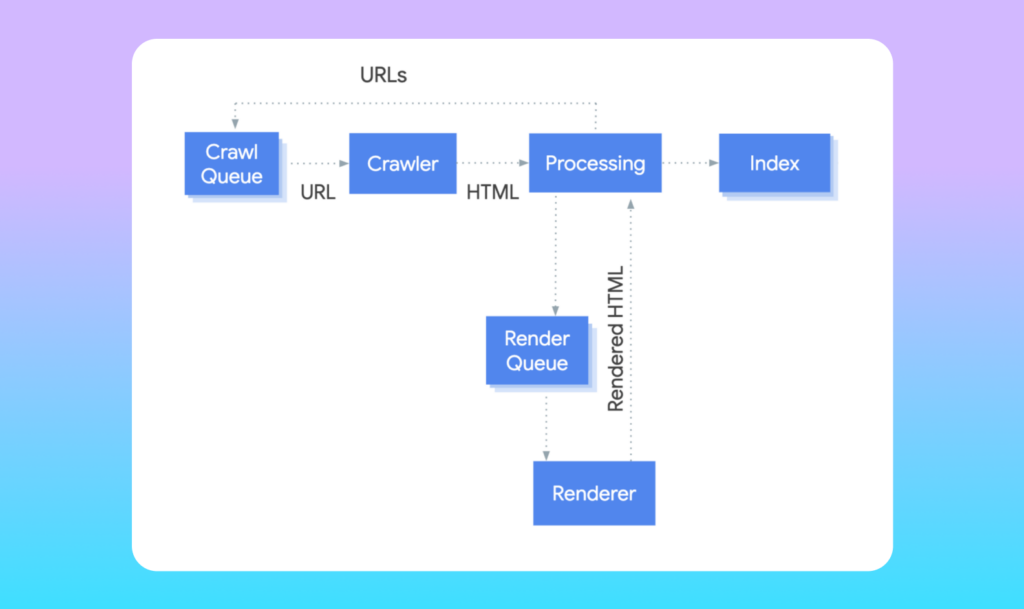
4) … And that your content is easy for search engines to find
Your homepage is your most important page. It is the entry point for the majority of crawlers and it passes on a huge amount of authority to your articles that are linked there, forcing fast indexation by search engines.
Having an optimized sitemap index and user-first site navigation is key. The golden rule of website navigation is “don’t make me think.” Which is why understanding your users (and website usability) is so important.
5) Improving content quality
This can be done in several ways. You may find that a lot of old content on your site is particularly thin when it comes to key information, particularly articles aimed at ranking in Google Discover or editorial ideas/content series that have been allowed to die over the years. Setting some standards around what quality content is (ideally from a news and evergreen perspective) will help minimize many smaller issues across the board.
6) Making the most of your crawl budget
If you work for a huge publisher and can see that your pages already tend to be crawled the same day they are published, crawl budget is unlikely to be a problem in terms of just getting your content crawled by search engines. But you want to ensure that Google prioritizes your most valuable content — this isn’t an easy feat. It means you must optimize your homepage, navigation, and internal linking strategy whilst cleaning up deadweight content from yesteryear.
A great starting point is to get access to your log files and to use a log file analyzer to get a clearer picture of the areas of your site that are crawled more or less frequently by search engines. It’s also worth reviewing the crawl stats and page indexation reports in Google Search Console to diagnose any immediate issues and to keep track of things over time.
7) Being best, not first (for news content)
Yes, I know I’ve shamedly ‘borrowed’ this from Barry Adams, but it is a superb way of looking at news content. It is a difficult one to manage as it’s very unlikely you’ll be in the position to enact this fully (and nor should you be, in most cases!). However, you can work towards ensuring articles are as accurate (and optimized) as possible before launch, running headline checks and checking Google Trends to make sure that Google’s first crawl over your content looks at the best version of the article.
Read more: Optimizing News Articles For Google’s First Crawl (Barry Adams)
8) Communicating the value of SEO to writers and editors
SEO helps get more eyes on your content — and there isn’t a writer alive who doesn’t want their content to be read by more people. But not everyone likes people dissecting their content or making suggestions, so it’s important to help people understand why headline and title tag alterations make a difference and why it’s important to link to tag pages. As Kevin Indig explains, the rise of The Athletic is a great example of why this is so important.
We have run multiple training sessions to improve editorial understanding of what we define as a quality headline (from an SEO standpoint) and other SEO strategies. Most large publishers will have a Slack channel or content management board for SEO headline checks. As long as the SEO team has a clear overview of the content going out and can optimize accordingly, you should be all set.
What to prioritize for news websites
OK, so where should I focus my time and efforts?
Based on my experience as SEO director at a large news website, I’ll try to set some guidelines around where you’re likely to find the majority of issues and opportunities for publisher websites, breaking things down into the foundational concepts of SEO.
Fundamentally, most publisher sites require the same due care and attention as any other website. If you’re primarily focused on improving the quality of your content, site speed, crawlability, navigation, headlines, internal linking, and UX, you won’t go far wrong.
It’s worth noting that because publisher websites, and particularly news sites, tend to be quite large and complex, technical SEO is also particularly important.
SEO consultant Aleyda Solis created a simple, straightforward visual to help you understand what type of SEO is likely to add value based on the size of your site:
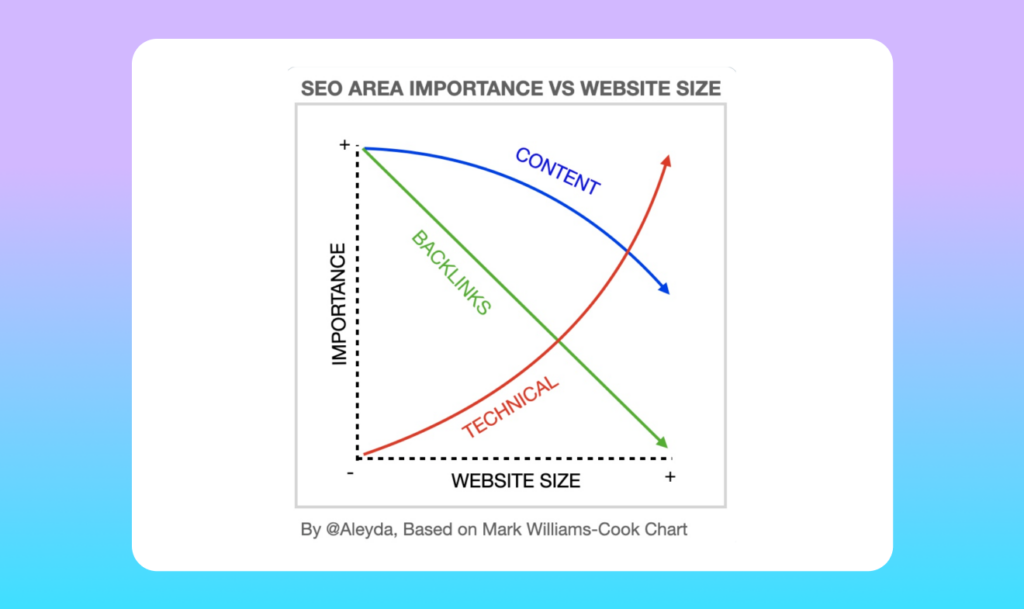
As she explains in the thread, the larger the website, the more important it is to get technical SEO right.
Technical SEO
Where should you start?
Technically, the challenges most publishers have stem from the fact the sites are large, fast-moving, and have a substantial amount of third-party code ‘required’ (I use required in the loosest possible sense of the word here).
When it comes to technical SEO, I always start by ensuring the content can be rendered, that the pages load appropriately, and all the basics (Google News Sitemap for example) are in play. Then we start cleaning up the site and making sure our priority pages are as accessible and prioritized as possible.
With so many projects underway at any one time and a typically sprawling site structure, getting a handle on the site’s current structure, internal linking, and use of tag pages should be top priorities.
Prioritizing the sections of the site that most closely align with your company goals in the navigation and on the homepage is a good start. Given the size and scale of some of these sites, you need to balance technical excellence with efficiency.
What do you need for technical SEO?
You’ll almost certainly need a cloud-based website crawler. One that can handle many hundreds of thousands or millions of URLs, with automated crawl options for monitoring important sections of the website.
Ideally, you’ll also have access to log files and a log file analyzer — and excellent working relationships with the tech and engineering teams in charge of the sitemaps, robots.txt file, and server logs for MarTech assets (paywalls, newsletters, etc).
Top tip:
Usually, publishers’ websites have had so many different developers, SEOs, designers, and engineers working on them over the years that the amount of sticking plasters and quick fixes can be a logistical nightmare. Start by establishing how teams work and what they know about the site. It will save you so much time.
Content SEO
Where should you start?
You must understand that for content-led businesses, SEO is primarily a support function. Your job is to make the content fly.
With news content, it’s your job to ensure article headlines (all 5 of them) are targeting the most relevant search queries, build high-quality internal links, and identify opportunities for ‘explainer’ content based on trending queries and competitor research.
When it comes to evergreen content, it’s worth establishing the priority pages or sections of the site, reviewing them, and beginning to set some standards around what quality evergreen content looks like at your organization, how it differs from news content, and whether or not your team is hitting those standards. The long introductions, lack of subheadings, shorter and less feature-rich pages associated with news won’t stand up to the rigor associated with the more traditional ranking factors that are in play for evergreen content.
(Note: As someone who initially came from more of a non-publisher SEO background, I’m almost ashamed to use the subheadings instead of h2s or h3s on news articles. Hopefully, the traditional SEOs amongst you will forgive me.)
“For content-led businesses, SEO is primarily a support function. Your job is to make the content fly.”
What do you need for content SEO?
You need to build good relationships with the editorial staff and understand what you can do to support them. This is more important in publishing than in any other industry. Nobody likes being told what to do — particularly writers who have been doing it for a long time.
Then you need to establish where you sit in the content wheel and what your role is as an SEO. Are you a support function? Do you lead on the content strategy for events and evergreen content? Do you brief the content? Should you? These questions are all vital in understanding where you can have the biggest impact.
When it comes to tools for content-focused SEO, you’ll need access to a content planning tool, something for competitor analysis, keyword research — the usual. I don’t think you need to do anything spectacular, you just need to immerse yourself in the company, the processes, and the plan.
Top tip:
Have a look at the briefs that writers work from and sit in on some initial content strategy meetings without saying much. Just try to get a feel for how things currently work at your publishing organization.
News SEO
News SEO and everything that comes with it is an entirely different prospect than any other type of SEO. It’s fast-paced, focuses on a few very key things, and requires more immediate attention than any other type of search engine wizardry.
What do you need for news SEO?
You’ll need to be au fait with Google Trends, Top Stories, Google Discover, Google Publisher Center, keyword tracking, and working on major news events. Get yourself organized early, support editorial teams effectively, and track stories in real-time with something like Chartbeat. It can make a huge difference in knowing when to suggest explainers, headline optimizations, or creating new files.
Top tip:
Google Discover can be feast or famine and, much like the Wild West, is largely unregulated. However, you can analyze what works effectively for you in terms of content category, headline length and type, publish time, etc. Set some clear standards for news desks about what works.
SEO team structure
The best team structure for publisher SEO completely depends on the requirements placed on you as an SEO team, how much resource you have, whether you have agency support, and how understanding and bought-in senior leaders are.
I have written a relatively detailed guide on how to set up an SEO team, but the best advice is to consider the site carefully when building a team. Larger, more complex sites are far more likely to need technical SEO resource than newer, smaller sites. And smaller publishers demanding more brand awareness are likely to benefit from some kind of digital PR and backlink acquisition.
It usually helps to start with some sort of framework if you’re setting up a team from scratch or restructuring the existing setup. So start with the basics:
- head of SEO
- technical SEO function
- news SEO function
Then consider what else would add value to the company’s goals — how could you best deal with evergreen content improvements, backlink acquisition, etc.
Top tip:
You need to work effectively with product, engineering, editorial, and design teams and know when and where they are making changes to the site. Your goal should be to understand the website better than anybody else.
E-E-A-T
E-E-A-T (Experience, Expertise, Authority, and Trustworthiness), a topic hotter than the sun in SEO, is of particular interest to publishers. Particularly those reliant on or looking to build their Google Discover traffic. It’s typically best to think of Discover as free traffic, but this excellent guide to Google Discover by Lily Ray should help demystify certain elements of the platform. Content that performs well for you in traditional search is likely to also perform well for you in Discover.
Even in 2024, the fundamental trust signal is high-quality, industry-specific links. Generating high-quality backlinks at scale is still one of the most challenging aspects of quality SEO and whilst there are other E-E-A-T signals you should work to deliver (author pages, Person markup, social shares), industry-specific backlinks are your way into new markets. Whether the market is a category of content or location doesn’t matter, the principles are the same. You need search engines to see that people in the industry trust you enough to link to you.
Top tip:
Reviewing the volume of content you publish is a really good starting point here. If you have years of experience writing about football and create 100 articles a week on the topic, you are far more likely to be an authority than something you only write 20 articles per week on. If you are trying to launch in new fields or you’re getting asked why certain content brings in far less traffic and revenue than others, understanding and optimizing your publishing volume is a great place to start.
SEO analytics
Where should you start?
You should start by defining a few key goals for your SEO team that directly feed into the company goals. If you work in a subscription-first business (like lots of publishers now are), then your traffic and ranking goals should directly correlate to the business goals. If the primary goal is to generate a 10% uplift in subscribers, then your traffic and ranking goals should be based on that figure.
If the goals are a little less tangible — for smaller companies, this might look like improving brand awareness (although if it’s something as vague as this you should suggest an alternative) — then you should consider investing in digital PR and set some link and mention targets.
What do you need?
You’ll definitely need access to Google Search Console, either Google or Adobe Analytics, a real-time content performance tool like Chartbeat, and access to internal user data that lets you track site search for example.
You will need a suite of custom reports built in something like Looker Studio that gives you immediate and unbridled access to multiple data sources neatly tied together. The last thing you want to do is spend hours knitting data together. Identify the issue and take a problem-solution approach to things.
Top tip:
To get around Search Console’s forever confusing 16-month data limit, pull your Search Console data into BigQuery. This will take time to become useful (around 16 months and one day to be precise), but will set you up for future success and goes part of the way to leaving the site in a better position than when you started, which should always be one of your goals IMO.
SEO FAQs for news publishers
1. Do publishers need technical SEO resource?
My opinion is the vast majority of publishers would benefit from technical SEO resource. Good technical SEOs open websites up like nobody else can and will help senior stakeholders get to grips with how crawlers understand their website. And the larger the site, the more likely it is to benefit from technical SEO.
2. Do publishers need a link-builder or digital PR expert?
Smaller publishers who are looking to improve their brand awareness (or larger publishers trying to crack a new market) would almost certainly benefit from someone being responsible for link acquisition. Typically, larger publishers who create hundreds of articles per day have much less need for someone working in digital PR than much smaller publishers. In my experience, the larger and more authoritative the site, the less value you’ll find out of link building.
3. Would you recommend working with an SEO agency?
If you have the budget to do so and there’s lots of background work that needs to happen, an SEO agency can be a great option for publishers. I think, in the long run, the best work you will do will happen in-house and that should be your long-term goal. But good agencies can add a huge amount of value in a short space of time. Just make sure you’re in a position to enact the technical changes that come up and that you ask them to explain the value behind making certain changes. If they can’t, it’s probably fine to skip it.
Summing up
There you have it. That’s everything you need to get started in publisher SEO. While the basic SEO principles are the same — create great content, make it load quickly, eliminate waste, and make it easy to navigate — the publishing industry is a fast-paced world that a lot of SEOs will be unaccustomed to. News SEO is a demanding, headline-focused beast that takes some navigating. But the rewards can be incredible.
Eventually, you’ll work out when to push, when to step back, how to structure the team, how to open doors, and the skillsets you need to hire.
This becomes much easier to manage if you think of SEO as a product and focus on the user. What do they want and what do you need to facilitate it? Once you frame SEO in that mindset, you’ll never look back!


